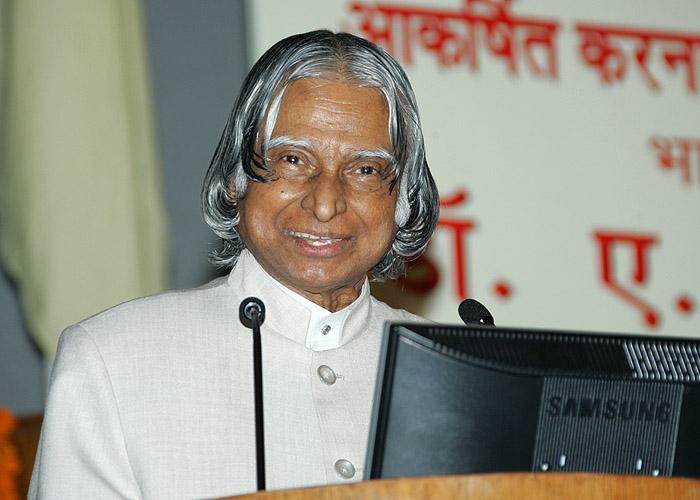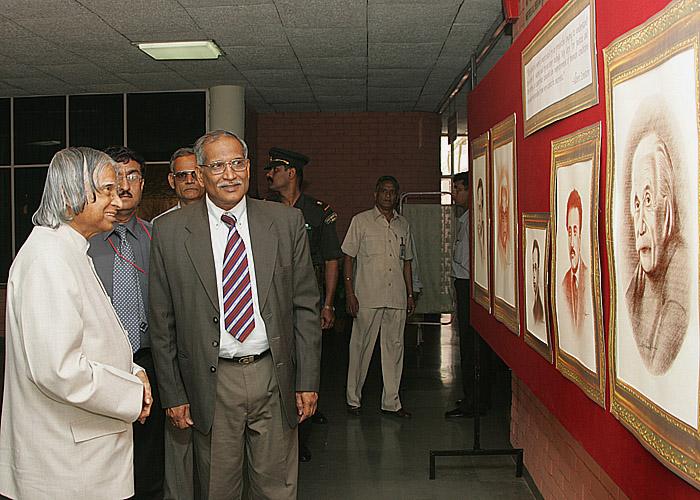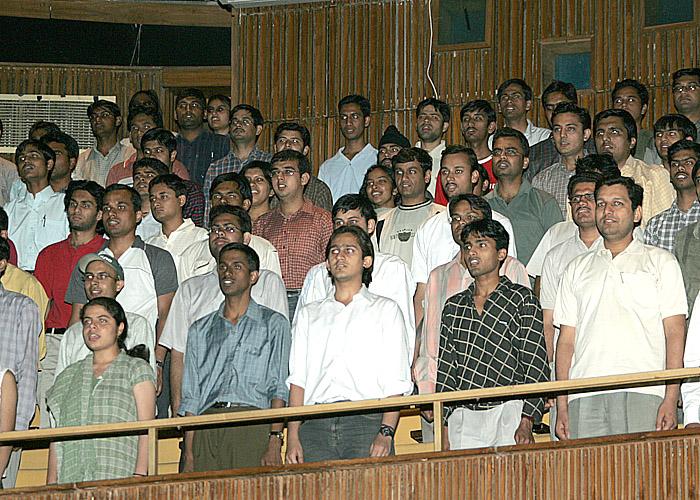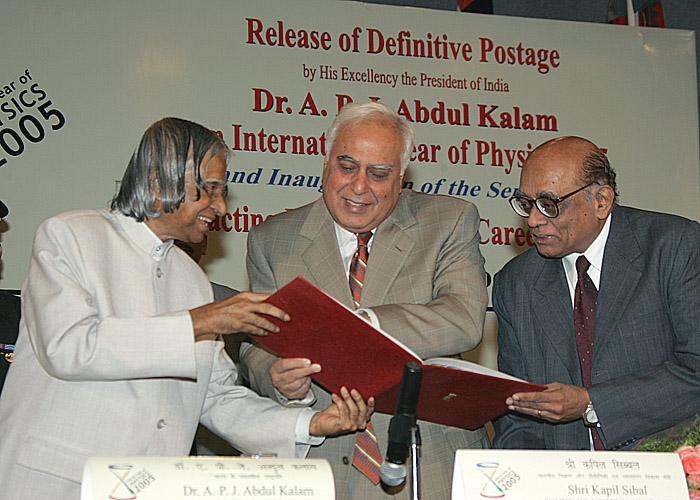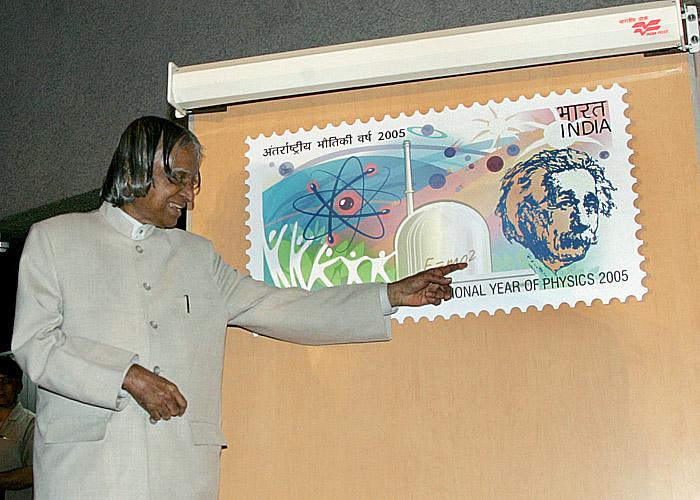Address at the Inauguration of the Seminar on 'attracting Young People to Careers in Science' Indian Physics Association Iit, New Delhi
New Delhi : 31-03-2005
Challenge to Science: Attracting the Youth
I am indeed delighted to inaugurate the seminar on "Attracting Young people to Careers in Science" organized by the Indian Physics Association on the occasion of the International Year of Physics - 2005. I greet the organizers, scientists, engineers, distinguished guests and the other participants in the seminar. Keeping in mind the main theme of the seminar, I would like to discuss with you about: "Challenge to science: Attracting the youth".
Great things - how do we achieve in science?
I would like to narrate an incident which happened during a programme for honouring Prof. Norman E Borlaug with Dr. M S Swaminathan award, at Vigyan Bhavan, New Delhi on the 15th of March 2005. Prof. Norman E Borlaug, at the age of 91 was in the midst of all the praise showered on him from everybody. First, he talked about India?s advancement in the agricultural science and agricultural production and the present status of agricultural science in India. He turned to the dais; he talked about Dr. M S Swaminathan and a political visionary late Shri C. Subramaniam who were the prime architects of First Green Revolution in India. He also recalled about Dr. V. Kurien who was the father of White Revolution in India. Then he turned to the audience and started identifying scientists such as Dr. Raja Ram, a wheat specialist, Dr S K Vasal, a maize specialist, Dr. B. R. Barwale, a seed specialist who was contributing in the agricultural advancement in India and abroad. Dr. Borlaug introduced them to the audience by asking them to stand and ensured that the audience cheered and greeted them with great enthusiasm. Here, I noticed a unique way of a 91 year old Nobel Laureate, who remembered and recognized all the key contributors to the agriculture mission irrespective of their position. This lesson, I would like the Indian scientific community to observe and follow, while dealing with all young scientists.
Let me tell you about another incident. Recently, my friend Dr. Vasant Gowariker sent me an executive summary of The Fertilizer Encyclopedia prepared by him and his team. The comment by Dr. Norman E. Borlaug on this document is noteworthy. I quote: ?Asian farmers in particular must now judiciously increase their per hectare use of fertilizer, looking for greater efficiency in use and also in dealing with deficiencies of secondary and minor elements of the soil? Unquote. This is how he sets the targets and provides encouragement for pursuing science across the world.
Another unique personality whom I remember, when I talk about science is Prof. C.N.R. Rao. I have visited his laboratory. He is a pioneer and an example of leading from the front. His research started from structure of molecules and that opened newer frontiers in surface sciences and more recently in nano particles and nano materials. He is one of the highly decorated Indian scientists. He is a motivator par excellence and pursues science with passion. Among the many awards he has received for his contribution in science, I would like to particularly mention the prestigious 'Dan David Prize' given to him by Dan David Prize Foundation headquartered at Tel Aviv University for his contribution towards the future time dimension in the filed of material science. In addition, he is the first recipient of 'India Science Award' announced on 28 Feb 2005.
Another important scientist in the field of medicine, I would like recall is Dr. P. Venugopal, Director, All India Institute of Medical Sciences, New Delhi. In his laboratory, he pioneered stem cell research in the field of cardiology. One of the cardiac diseases, where conventional medical and surgical treatment were ineffective because of the affliction of the heart muscle, stem cells implantation into the diseased heart muscles had been applied in order to improve the function of heart muscle. This kind of application of this procedure is the latest and very few cases have been done in the world, the first time in India. This is expected to open new frontiers in the treatment of patients for regeneration of heart muscles, thereby giving new hope for the patients suffering end stage heart disease. The commitment of Dr. P. Venugopal for research ultimately results in saving hundreds of lives.
I have mentioned these names only to assure ourselves that the Indian science has great future.
Empowering the Young Scientists
I remember an incident with Prof. Vikram Sarabhai during the 1960?s. There were a few scientists and technologists, whom Dr. Sarabhai nurtured. I would like to share with you how he nurtured them. Whenever he comes to Trivandrum, I used to discuss with him the proposal for the development of Composite Products. At that time I was in the initial stages of my career as rocket engineer, with less than 2 years of experience in ISRO.
Similarly, there was Dr. SC Gupta, a specialist in guidance and Dr. Amba Rao a specialist in Aerospace structures. In spite of our being just introduced into the organisation with few years of experience, noticing our interest in development of certain materials and systems Dr. Sarabhai funded for the creation of laboratories. He created fibre composite laboratory based on my proposal, which later became Reinforced Plastic Centre. He created Gyro laboratory centered on the expertise of Dr. Gupta, which later became Guidance Laboratory and space structures laboratory centered around Dr. Amba Rao, which later become advanced dynamics group. These centres became the centres of excellence and incubated many advanced technology missions that fed critical inputs to space programme. Once the potential of the young scientist is understood, the heads of the organisation must invest on them boldly irrespective of the positions of the scientists and their age considerations. If this philosophy is pursued with sincerity the research would flourish and youth would be encouraged to embrace science.
Great Indian Scientists
In India, science and technology took a two-phase progress with the momentum created in 1930s, by the great scientists of international repute. They gave the country the confidence. We may remember the pioneering contributions to science made by Chandrasekhar Subramaniam for his Chandrasekhar limit and black hole, Sir CV Raman for his discovery of the "Raman effect?, Srinivasa Ramanujan for his contributions towards number theory, JC Bose in the area of microwaves, Meghnad Saha for "Thermo-Ionization Equation". This phase, I consider the glorious phase of Indian science. This scientific foundation laid by them always triggered the later generations also. The unique similarities of all these scientists are the one that they had dedicated their entire life for the cause of scientific research and the spirit of inquiry for the fields that they have chosen amidst all the hurdles and problems in their life as well as their career. Science always gives life time missions to the scientists, and then only success comes. They have not deviated towards the other worldly prospects or towards their own career advancements. This quality helped them to make singular contributions for the benefit of science and the world. It is a question of dedication, commitment and understanding and also the environment for research in science, which gives birth to the scientists for the nation. They inspired many later generation scientists including GN Ramachandran, the originator of triple-helix.
Let me now discuss on how India has attracted large number of scientist and engineers towards drawing the road map for achieving self-reliance in critical technologies in defence, space and atomic energy.
The post-independence phase of Indian science and technology
All of you know, in history, any country reposes its confidence initially among a few stout and earnest knowledge giants. Particularly I took interest to study the lives of three scientists, as I was interested in their scientific technological leadership qualities that focused the relationship of S&T and development of the nation. In the history of India, there may be many but I was very close to these three great personalities for one reason or the other. They are founders of three great institutions. I worked in two of the institutions directly and one in partnership. Dr DS Kothari, a Professor in Delhi University was an outstanding Physicist with special interest in Astrophysics. He is well known for ionization of matter by pressure in cold compact objects like planets. This theory is complementary to epoch making theory of thermal ionization of his guru Dr Meghnad Saha. Dr DS Kothari set a scientific tradition in Indian defence tasks when he became Scientific Adviser to Defence Minister in 1948. The first thing he did was to establish the Defence Science Centre to do research in electronic material, nuclear medicine and ballistic science. He is considered as the architect of defence science in India. His race continued and followed up with a momentum working and contributing in the areas of strategic systems, electronic warfare systems, armaments and life sciences.
Now, let me discuss about Homi Jehangir Bhabha. He did research in theoretical physics in Cambridge University. During 1930-1939, Homi Bhabha carried out research relating to cosmic radiation. In 1939, he joined Sir CV Raman in IISc Bangalore. Later, he was asked to start Tata Institute of Fundamental Research with focus on nuclear science and mathematical science. He subsequently established Indian Atomic Energy Commission in 1948. Multi centers were born with his vision in nuclear science to nuclear technology, nuclear power, nuclear devices and nuclear medicine. These science institutions established multi technological centers, but basic science was the vital component.
The youngest of the three was Prof Vikram Sarabhai and he worked with Sri CV Raman in experimental cosmic ray. Prof Sarabhai established Physical Research Laboratory in Ahmedabad with Space research as focus. In later years he became the Director of Space S&T Centre. The SSTC (1963) started with the launching of sounding rockets for space atmospheric research. His vision transformed Indian Space Research Organisation (ISRO) into multiple space technology centers. These centers are responsible for development and leading to launch of PSLV in the sun synchronous orbit. And we have also witnessed a launching of GSLV in the geo-synchronous orbit with communication satellite.
I have talked about the three personalities, Dr. D.S. Kothari, Dr. Homi Baba and Dr. Vikram Sarabhai. All the three of them were physicists, who went on to build huge S&T institutions that became the home of more than 20,000 young scientists and engineers and also the kindler of their innovativeness. I believe strongly that if the three scientists had gone on to concentrate only on science, at least one of them would have got the Nobel Prize, but India would not have had the advantage of having the atomic energy, space and defence research establishments in the country with this magnitude. We must take the message and the mission of successful scientists such as Raman, Chandrasekar, Kothari, Homi Bhaba and Sarabhai to the youth so that they will understand the various ways by which one could contribute to the growth of the nation, if they take science as a career. This would surely attract many young people towards science.
Importance of science in the present context
As soon as we became independent, the country was infested with problems to bring in urgently needed technologies for steel, civil structures, hydro dams and thermal power stations. Our concentration was directed towards solving burning problems like feeding the population, providing water, shelter and health care. The political visionaries at that time, in spite of our having a very weak economy, decided to wisely setup what ultimately has become the science base of our country such as Atomic Energy, Space, CSIR, DRDO, DST etc., The country also setup the powerful educational base including the creation of IITs and many universities, which had a unique blend of science and technology.
Today the country has become one of the strongest in the world in terms of scientific manpower in capability and maturity. Our economy has also become strong. Hence, we are in a position not only to understand the technologies that we may have to borrow, but also to create our own technologies with extensive scientific inputs of indigenous origin. This, in fact, would do a value addition. In many areas such as Pharma, we are delivering to the world, products which are backed by large amount of R&D. Basically we have come a long way since our independence, from mere buyers of technology to those of who have made science and technology as an important contributor for national development and societal transformation. In a world where the powers are determined by their share of the world?s knowledge, reflected by patents, papers and so on, the WTO starts to play a crucial role in the economic development. It is important for India to put all her acts together to become a continuous innovator and creator of science and technology intensive products. The science that we do today must have the innovativeness and the foresight and the vision for it to be the centre of the technology that we develop tomorrow for the competitive world.
Scientific challenges for the future
In the last three decades, we have witnessed an unstinted growth in miniaturization of IT products in the world. Central to this is the silicon technology. The feature size of the transistors has been decreasing relentlessly. It is predicted that the miniaturization using silicon ? micro electronics will find its plateau and its limit will be reached within the next decade. The world is on the lookout for an alternative to silicon. The transformation from microelectronics to the nano science and nano technology is knocking at our doors. The endless alternatives include molecular transistors, quantum computing, nano electronics and so on. India has the good science base needed for being a pioneer in making this breakthrough a reality.
In addition to the above, the challenges facing Indian scientists in the coming decades will be the development of anti vaccine for HIV/AIDS and development of seeds for agricultural products which requires minimum water and can provide high yield per hectare to compensate the reduced availability of land. Apart from this, there is a need to work on thorium based nuclear power plants, integrated mission for stem cell research, launching of hypersonic reusable launch vehicle and take discoveries and innovations to provide better quality of life to the differently challenged people. These are some of the challenges facing the scientific community in the coming decades.
Conclusion
I would like to make the following suggestions for attracting the young people to careers in Science.
1. It is essential to have an assured career in science for a certain number of high quality committed scientists with aptitude towards research. There should be a minimum annual intake of about 300 M.Sc and 100 Ph.D scientists with proper emoluments and assured career growth in the organisations such as ISRO, DRDO, Atomic Energy, CSIR, DST and the Universities. The private and government funded universities must be encouraged to appoint M.Sc and Ph.D who have been selected through a nationally coordinated competitive selection process. This will be a great motivator for the science students and also their parents for pursuing advanced courses in science. This is the first and foremost need for attracting young people to career in science ? an assurance to the youth and the parents that the future is secure, once they take science as a career.
2. The experienced scientists and policy makers of the organisations must recognize the talents available in the organisation irrespective of the position and empower the young scientists to create state-of-the art laboratories once they have concrete thoughts and vision. Prof Vikram Sarabhai in the initial stages of ISRO brought in a culture of management which encouraged and satisfied the vision of the young scientists which collectively succeeded in making the mission of the organisation a reality.
3. Universities and Research and Development institutions must encourage and facilitate the young scientists to write quality research papers in frontier areas and in prestigious journals. They should also facilitate the youth to present the papers in national and international seminars and symposiums which will enable them to assess their standard against international benchmarks. Encouraging youth to be lead authors while publishing the joint research would be a very good gesture that the youngsters would cherish for many years.
4. Based on my experience during my interaction with the 600,000 students, I realize that they are looking for role models, whom they would like to follow after their 10+2 career. Approximately 7 million students appear for plus two examinations every year. Out of which 3 million students are from the science stream. To attract this youth towards a career in science, we need many novel ideas. The youth must be made to understand the beauty of doing science, the pleasure of doing science and the ultimate bliss when the results of science make you understand the nature, master it, control it and finally make things that improve the quality of life of the human kind. Every one of us, scientists must pledge that we will at least spend sometime visiting the schools to ignite the young minds by recounting our own experiences.
My best wishes to the organizers of this conference for fruitful discussions and generation of ideas for attracting young people with passion and aptitude for a life of science and in science.
May God bless you.

